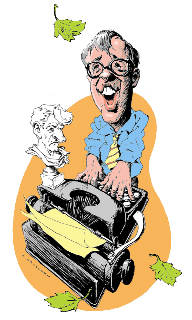The Leningrad marvel continues. Thursday night’s concert at the Music Center,
the second of four by the visiting Leningrad Philharmonic, once again drew a
capacity crowd and gave it plenty to cheer. Mariss Jansons, the orchestra’s
associate conductor was in charge, remembered here for the Tchaikovsky
Festival concerts he led with the Los Angeles Philharmonic in the spring of
1988.
No greater contrast in podium manner exists than between Jansons’ clear,
classic beat and his unassuming stance and the flamboyant demeanor of his
colleague, Yuri Temirkanov that’s the real spelling [F/L] as witnessed at
Wednesday’s concert. Both, however, drew resplendent results, an amazing
display of orchestral discipline, beautifully balanced tone and stunning
control over dynamics.
Jansons’ program, once again, was Prokofiev/Tchaikovsky: a suite of “Romeo
and Juliet” ballet excerpts and the one-movement First Piano Concerto by the
former, and Tchaikovsky’s Fifth Symphony. Dmitri Alexeev was the capable
soloist in the concerto, a strange, vacillating work (robust romanticism one
minute, brittle abrasiveness the next) interesting mostly as the pad from
which a brilliant career would someday be launched. {E/P]
The Tchaikovsky, as you might have guessed, was the evening’s major triumph.
What was there, you had to wonder, that made this performance under Jansons
satisfying in exactly the way last week’s performance here by the Japan
Philharmonic was not? It wasn’t just a matter of nationality; plenty of non-
Russian orchestras do spectacularly well by Tchaikovsky.
No, it had to do with matters of eloquence. Both performances were note-
perfect; both took some fearsome risks with breakneck tempos in the finale.
But the one, the Japanese performance, seemed to stop at putting the notes
across. Under Jansons, and with some stunning solo work from all over his
orchestra — the brooding, stark clarinet tone, the extraordinary playing of
the horns, not only in the famous “Moon Love” solo but elsewhere in their
soft, muted punctuation — you heard long, oratorical lines of thought, a
sense of building relatively simple ideas into grandiose structures. This time
the Tchaikovsky Fifth resounded as a masterpiece; the last time it didn’t: as
simple as that.
Some details were fascinating. The orchestra is seated with the first and
second violins down front on either side, behind to the right and cellos and
basses to the left. Violins down front lend a special brilliance to any
orchestra. Toscanini favored that arrangement; now it is generally out of
favor except for “authentic” early music ensembles. But a lot of
Tchaikovsky’s scoring seems to demand a special kind of interchange, back and
forth across the stage between the two groups of violins, and those effects
were nicely brought out in this week’s performances.
Someday, in a better world, all orchestras will sound like this.
-

-
Categories
-
-
Archives
- April 2010
- February 2010
- December 2009
- November 2009
- October 2009
- September 2009
- June 2009
- May 2009
- April 2009
- March 2009
- February 2009
- January 2009
- December 2008
- November 2008
- October 2008
- September 2008
- August 2008
- July 2008
- June 2008
- May 2008
- April 2008
- March 2008
- February 2008
- January 2008
- December 2007
- November 2007
- October 2007
- September 2007
- August 2007
- July 2007
- June 2007
- May 2007
- April 2007
- March 2007
- February 2007
- January 2007
- December 2006
- November 2006
- October 2006
- September 2006
- August 2006
- July 2006
- June 2006
- May 2006
- April 2006
- March 2006
- February 2006
- January 2006
- December 2005
- November 2005
- October 2005
- September 2005
- August 2005
- July 2005
- June 2005
- May 2005
- April 2005
- March 2005
- February 2005
- January 2005
- November 2004
- October 2004
- September 2004
- August 2004
- July 2004
- June 2004
- May 2004
- April 2004
- March 2004
- February 2004
- January 2004
- December 2003
- November 2003
- October 2003
- September 2003
- August 2003
- July 2003
- June 2003
- May 2003
- April 2003
- March 2003
- February 2003
- January 2003
- December 2002
- November 2002
- October 2002
- September 2002
- August 2002
- July 2002
- June 2002
- May 2002
- April 2002
- March 2002
- February 2002
- January 2002
- December 2001
- November 2001
- October 2001
- September 2001
- August 2001
- July 2001
- June 2001
- May 2001
- April 2001
- March 2001
- February 2001
- January 2001
- December 2000
- November 2000
- October 2000
- September 2000
- August 2000
- July 2000
- June 2000
- May 2000
- April 2000
- March 2000
- February 2000
- January 2000
- December 1999
- November 1999
- October 1999
- September 1999
- August 1999
- July 1999
- June 1999
- May 1999
- April 1999
- March 1999
- February 1999
- January 1999
- December 1998
- November 1998
- October 1998
- September 1998
- August 1998
- July 1998
- June 1998
- May 1998
- April 1998
- March 1998
- February 1998
- January 1998
- March 1992
- February 1992
- January 1992
- December 1991
- November 1991
- October 1991
- September 1991
- August 1991
- July 1991
- June 1991
- May 1991
- April 1991
- March 1991
- February 1991
- January 1991
- December 1990
- November 1990
- October 1990
- September 1990
- August 1990
- July 1990
- June 1990
- April 1990
- January 1990
- July 1989
- June 1989
- May 1989
- April 1989
- March 1989
- February 1989
- January 1989
- January 1983
-

Alan's Poppies and Sage, photographed by Paul Cabanis, Spring 2010.


